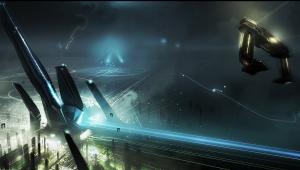The Setup: DVD Players Page 4
Some players offer additional setup options like access to special audio tracks for visually impaired viewers, extended subtitles for hearing-impaired viewers, virtual surround sound processing for simulated multichannel audio from just two speakers, optimized pause/still display, and parental lock/blocking controls. Your player might even have a karaoke feature for when you just have to channel the spirit of Elvis.
Once you configure your new player the way you want it, you'll probably never have to access the setup menus again, unless you upgrade to a system with an A/V receiver and a multichannel speaker array - a move I highly recommend!
Giving Your Receiver the Right Signals Since you're reading this magazine, you probably bought a DVD player to use in a home theater system. After all, along with its extraordinary picture quality, one of the most exciting things about DVD is its ability to deliver full-range surround sound and immerse the viewer in a room-filling sound field. But to deliver that kind of sound, a DVD player's digital audio output must be connected to a Dolby Digital or Dolby Digital/DTS receiver, which will decode it for multichannel playback.
The key concept here is to get the DVD player and the receiver to "talk" to each other. If the onscreen menus for either component aren't properly configured, you'll get less than optimal sound - or no sound at all. DVD-Video discs can carry 5.1-channel Dolby Digital or DTS, 6.1-channel Dolby Digital Surround EX and DTS-ES, and Dolby Digital-encoded mono, stereo, or four-channel (Dolby Surround) soundtracks as well as the same two-channel PCM audio you get from CDs (PCM encodes the sound without the compression used for Dolby Digital and DTS). While all newer players can read any of these soundtracks from a disc and supply it to a receiver, what you'll actually hear depends both on your receiver's decoding capabilities and on how you've set up the player's digital output.
First, connect the player to the receiver. Most newer receivers have a dedicated DVD input for video signals, and some have DVD audio inputs as well. Use the best available video connection, preferably component- or S-video, and hook up the player's optical or coaxial digital audio output (either will work fine) to the corresponding input on the receiver. (Some receivers require you to "assign" the digital input jack to a specific source - see below.)
Be aware, though, that receivers that let you view onscreen menus via the component-video outputs have only recently become available. If you have a TV with component-video inputs and an older receiver, you'll either have to do your setup with a composite- or S-video connection and then switch to a component connection when you're finished, or run the video directly from the player to the TV, bypassing the receiver. (In the latter case - which is illustrated on the facing page - you'll want to have a composite- or S-video connection from the receiver to the TV so you can see the receiver's onscreen menus.)
Some receivers can't tell which digital input you've plugged the DVD player into, so you might have to use the receiver's setup menu to assign that input to the player. You won't have to do this, though, if the receiver has a set of inputs labeled DVD.
Now go to the player's Audio Out menu and choose "Bitstream" for Dolby Digital (and DTS if your receiver has a DTS decoder) to deliver the correct digital output for multichannel digital audio playback. Then just set the receiver for Multichannel Digital Audio Playback, and . . .
Wait! - a couple more things. Some DVDs require you to select the type of audio playback you want from the disc's menu. If you don't, you might get two-channel instead of multichannel sound. (This is not one of my favorite DVD features.) Also, some older DVD players require you to turn off the analog audio outputs when playing DTS-encoded soundtracks to avoid the horrible noise of an undecoded DTS signal. Your manual should warn you about this, but you might have to dig through the fine print. (All players will mix a Dolby Digital soundtrack down to two channels and decode it to analog stereo even if they don't have a "full" Dolby Digital decoder, but they can't do this with a DTS digital soundtrack.) Okay - now you can sit back and enjoy the show.




























































